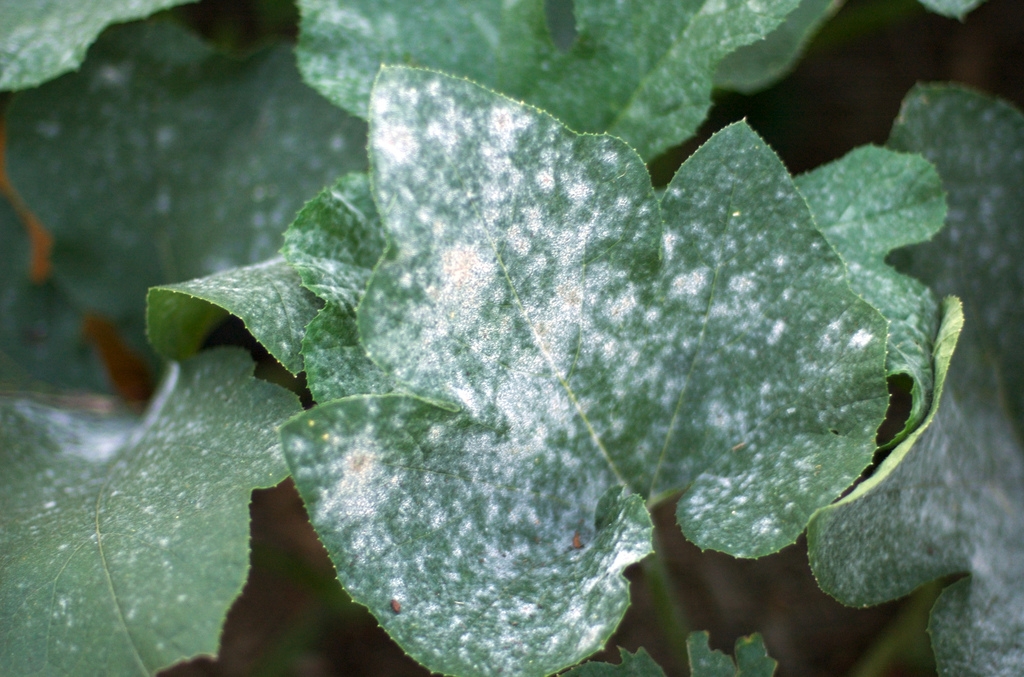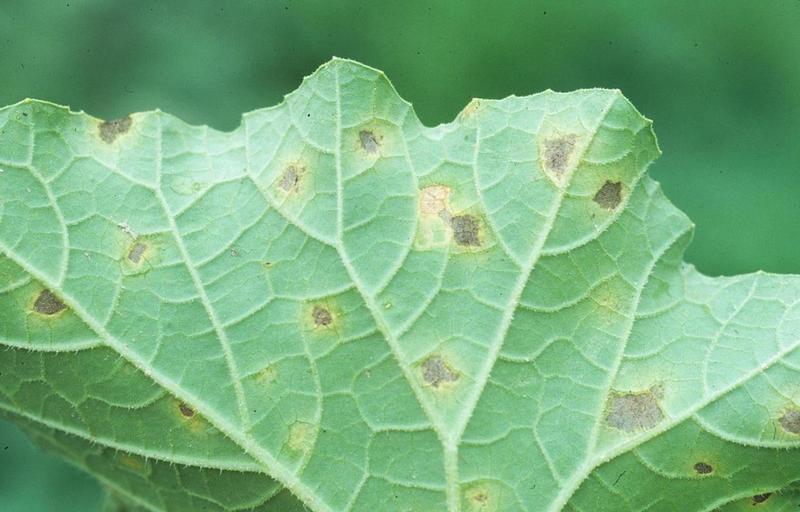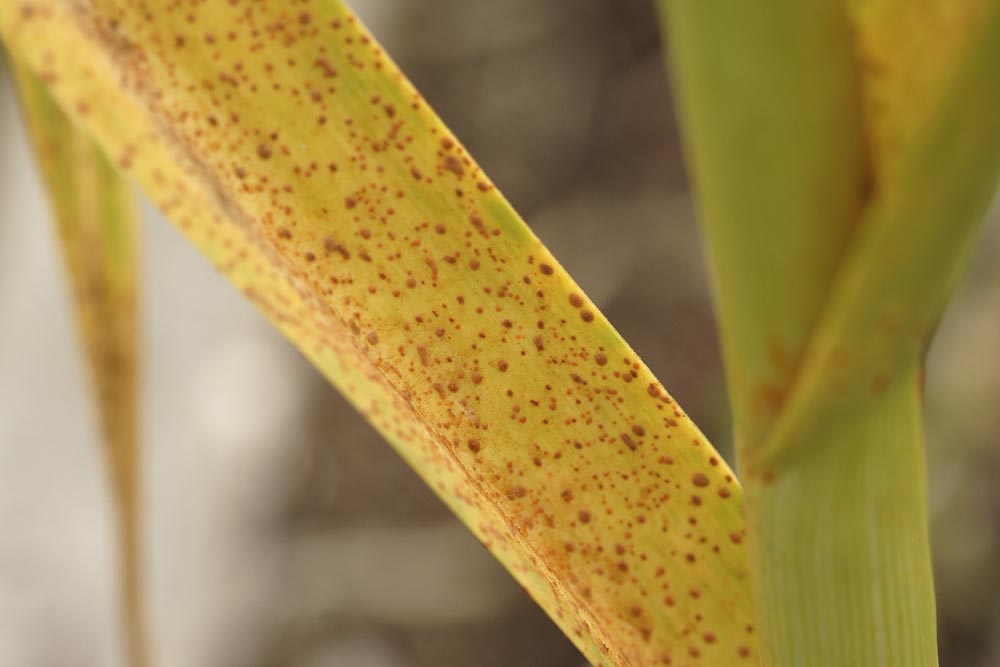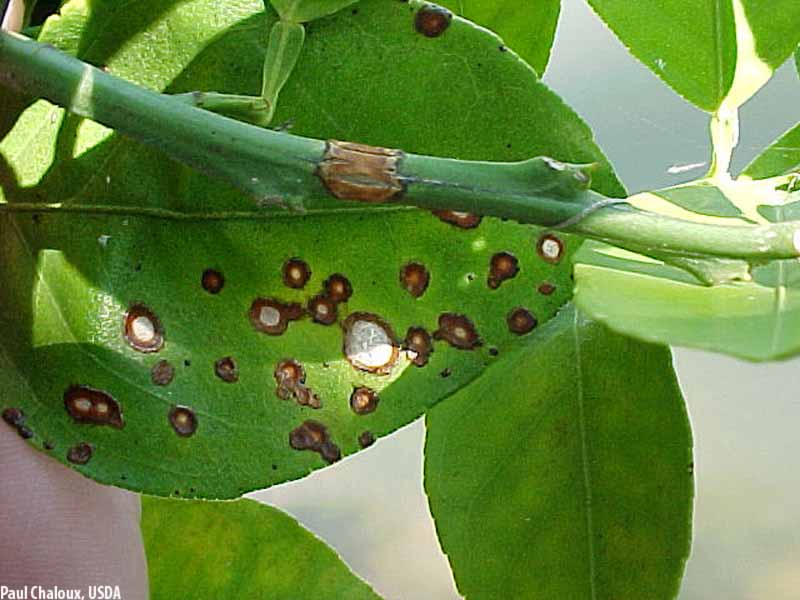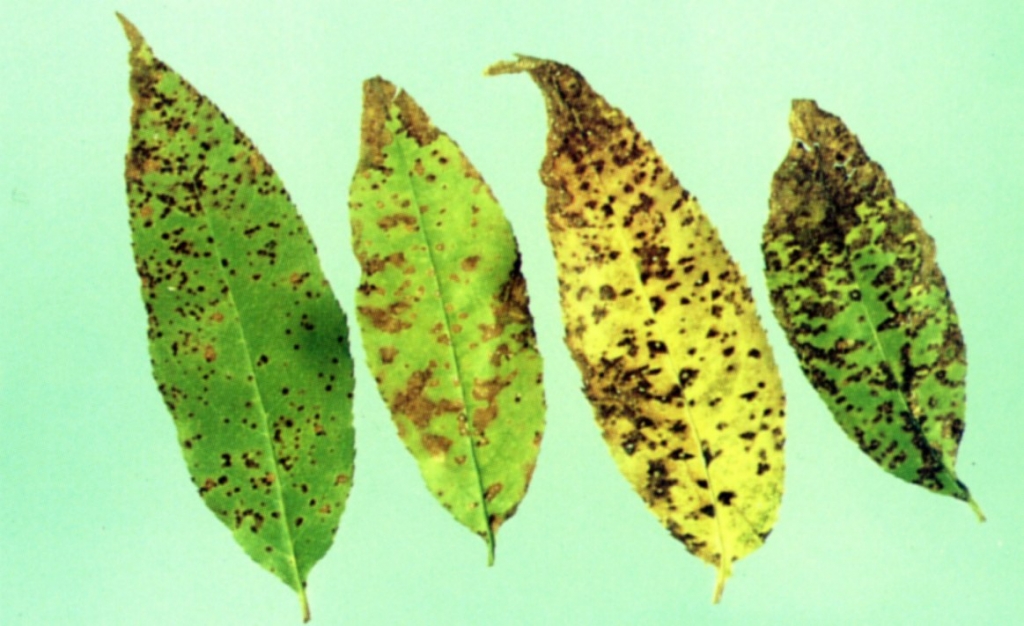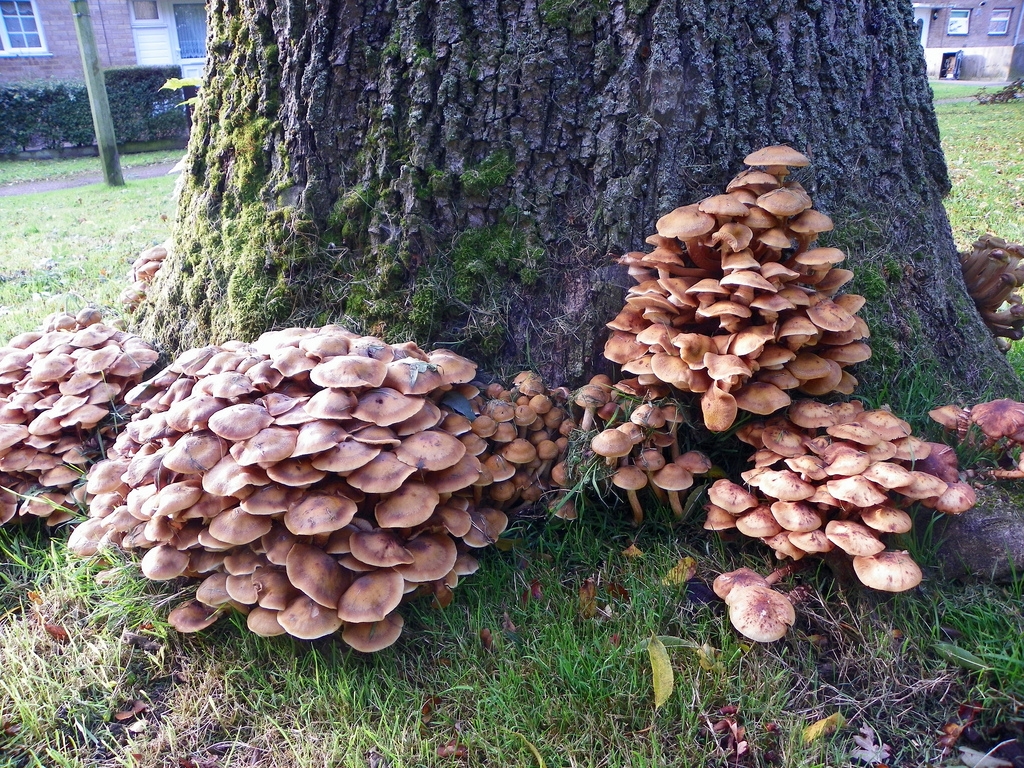Fungal Diseases
The most common fungal diseases in Los Angeles County are
- powdery mildew
- downey mildew
- rust
- anthracnose
- leaf spots
- phytophthora root rot
- armillaria root rot
Refer to the following for general information on each.
Powdery Mildew
Powdery mildew is common on many landscape plants and can be expected to occur whenever a susceptible host is used in a landscape. Powdery mildew appears as grayish or white powdery growth on leaves, stems, and fruit. New growth is highly susceptible and can be dwarfed and distorted due to infection. Species that are susceptible to powdery mildew include euonymus, strawberry, grape, stone fruits, heavenly bamboo, apple, crape myrtle, rose, and sycamore. The most effective means to manage powdery mildew is to select species that are not susceptible to powdery mildew or resistant cultivars of susceptible species. Some common landscape species, such as heavenly bamboo (Nandina domestica), become infected with powdery mildew when planted in shade. Powdery mildew on crape myrtle (Lagerstroemia indica) is more severe on heavily shaded trees compared to trees growing in full sun.
Resistant cultivars are available for many roses, euonymus, crape myrtle, and sycamore. Several varieties of London plane tree (Platanus acerifolia) are resistant to powdery mildew including ‘Columbia’, ‘Liberty’, and ‘Yarwood’. The native western sycamore, Platanus racemosa, is highly susceptible to powdery mildew. Resistant roses include ‘Meidiland’, ‘Simplicity’, Rosa rugosa varieties, and glossy-leaved varieties of hybrid tea and grandiflora.
Chemical control of powdery mildew requires frequent sprays to achieve effective control. Various fungicides are available that act as either foliar protectants or as a curative treatment. Potassium bicarbonate, sodium bicarbonate, and sulfur are common treatments that act as foliar protectants. These materials need to be applied prior to infection or before the infection becomes extensive. Applications need to be repeated at regular intervals to protect new growth or replace material that has washed off of leaves and stems. Horticultural oils such as JMS Stylet Oil, jojoba oil, Sunspray and Neem oil can act as curatives when applied early to slight or moderate infections. There are broad spectrum fungicides that act as foliar protectants and are effective for the control of powdery mildew. There are also fungicides that are curative. Before using any of these, the County Plant Pathologist should be contacted for a positive identification and management advice.
Downy Mildew
Downy mildew should not be confused with powdery mildew. Downy mildews are caused by Oomycetes (watermolds) in the genera Bremia, Sclerospora, Pernospora, Plasmopara, Pseudopernospora and other genera. Downy mildew is characterized by soft or fluffy gray, purple or light brown growth on the underside of leaves. It rarely occurs on the tops of leaves. The tops of the leaves will show pale yellow or purplish to brown lesions. While downy mildew can be mistaken for powdery mildew, downy mildew almost always occurs on the underside of leaves while powdery mildew will occur on both sides. Environmental conditions that favor downy mildew include low temperatures, high humidity, and free moisture on the leaves (wet foliage will actually suppress powdery mildew). Ornamental plants that are susceptible include rose, aster, impatiens, foxglove, pansy and coneflowers. Vegetables and fruit vines that are susceptible to downy mildew include spinach, squash, watermelon and grape.
Control downy mildew by selecting resistant varieties or species, avoiding overhead irrigation and increasing air circulation by thinning canopies. There are fungicides that will control downy mildew, but as with other plant diseases, the County Plant Pathologist should be contacted for a positive identification and management advice.
Rust
Rust diseases are common on a variety of ornamental plants used in landscapes. The fungi that cause rust disease may have up to five spore stages and two or more different hosts. Susceptible hosts include carnation, chrysanthemum, birch, cottonwood, fuchsia, hawthorn, juniper, pear, pine, poplar, rhododendron, grasses and rose. Rust diseases are characterized by reddish, orange, purple or black spore masses that form on infected tissue, usually on the undersides of leaves. Rusts that infect pines may form galls on branches or sporulate directly on the trunk. The disease usually begins as yellow spots on the upper surface of leaves. Mild and moist environmental conditions favor spore germination and infection. Rust spores are moved by wind and rain splash.
Control of rust diseases depends on the selection of resistant varieties or immune species. Avoid overhead irrigation as this can move rust spores and favors spore germination. Remove any infected plant parts. Collect and dispose any infected leaves, needles, and branches. Improve air circulation by increasing the space between plants. Spring applications of fungicides can reduce some rust diseases but the application frequency required may not be practical.
Anthracnose
Anthracnose (pronounced anne-THRAK-nōs) is a disease that occurs on caused by fungi from various genera including Colletotrichum Glomerella, Discula, Gleosporium, Gnomonia and others. The most common symptoms are angular leaf spots and foliar blight. Species that are most susceptible include redbud, ash, elm, oak, sycamore, and dogwood. Anthracnose fungi occur mostly on leaves and twigs but can cause large cankers on some hosts such as elm. The fungi responsible for anthracnose overwinter as infection on twigs on deciduous hosts. Wet and cool conditions in spring favor infection. Repeat infections occur when wet weather is prolonged. The progress of the disease slows and stops during warm dry conditions.
Management of anthracnose depends on selecting resistant varieties and pruning out infected twigs and branches. If the infection becomes severe, the disease cannot be controlled during the current season. Applications of fungicides are usually not practical for medium to large trees. Smaller trees such as dogwood can be sprayed with broad spectrum fungicides in early spring. Through coverage of all new growth as buds open is required. Spraying will need to be repeated about every two weeks if wet conditions persist.
Leaf Spots
Several fungi can cause leaf spots on susceptible hosts. Septoria species can infect aspen, azalea, cottonwood, hebe, and poplar. Septoria leaf spots may be angular or round and sunken, occurring mostly on older leaves. The spots may start out dark brownish purple and then develop light brown or gray centers with dark borders. Environmental conditions that are conducive to infection are similar to anthracnose diseases. Select resistant varieties or species. Avoid overhead irrigation and remove infected twigs and leaves at the end of the season. Entomosporium leaf spots can occur on apple, crabapple, hawthorn, loquat, pear, photinia, pyracantha, quince, and toyon.
The leaf spots start as small red spots and can be bordered by red, purple or yellow. Leaf spots will enlarge as the leaf matures. Spores are spread from infected leaves and twigs by rain and overhead irrigation. The fungus overwinters in fallen leaves. Wet weather during the onset of new growth is highly favorable to disease development. Manage the disease by removing infected leaves and stems. Collect and dispose of fallen leaves that were infected and avoid overhead irrigation. Copper-based fungicides can be effective when applied prior to infection, usually in early spring.
Phytophthora Root Rot
Phytophthora (pronounced fy-TOF-thor-a) is a genus of pathogenic fungus-like organisms that infect plants, especially roots, causing root rot. Phytophthora is a type of water mold, growing best in an environment of free water in the soil or on foliage. The name Phytophthora means ‘the plant destroyer’. Phytophthora is arguably the most destructive plant pathogen in the world, being the most serious disease of numerous agricultural crops and landscape plants. The cost of damage to crops caused by Phytophthora species in the United States alone runs into billions of dollars every year. The most infamous species of Phytophthora is P. infestans, which is the disease that destroyed Ireland’s potato crop in 1845 and 1846, resulting in the Irish potato famine.
Common phytophthora root rots include those of avocado, citrus, pine, pineapple, camellia, azalea, tomato, carrot, rhododendron, oak, and many more. Some species of Phytophthora, such as P. infestans, can cause disease on only a few plant species, while others, such as P. cinnamomi, cause disease on more than 900 species of plants. Although most Phytophthora species cause root rot, many also cause diseases that affect leaves, branches, twigs, and fruit. A new disease of oaks, sudden oak death, was observed in 1995 in California and has since been shown to be caused by a new species of Phytophthora, P. ramorum.
Symptoms of Phytophthora
Plants in the early stages of phytophthora root rot show symptoms of drought and starvation because the damaged roots can no longer draw water from the soil. Trees and shrubs exhibit poor growth, thinning of the canopy, tip die-back, small leaves, cupping of the leaves, poor leaf color, wilting, bud drop, poor flower production and small fruit or no flowers or fruit.
Shrubs will often die one stem or branch at a time. Young trees suffering from phytophthora root rot are usually stunted and tend to just sit for long-periods with no new growth. Phytophthora can move from the roots to the trunk causing cankers that bleed and exude gum. Trunk cankers can appear dark brown or black and be sunken or depressed. In the absence of controls infected plants usually die.
Usually the tips of the roots are infected and killed first. Healthy root systems have many white root tips, and the roots are plump and firm. The root systems of infected plants have very few or no white root tips. The small feeder roots that are infected by Phytophthora will be dead and dark brown or black. In some plant species, such as citrus, the infected roots will slip or sluff off leaving a thin white thread or strand, which is the center of the root. In other plant species, such as avocado, the feeder roots will turn black and become brittle. Large roots will develop dead, dark brown to black lesions. Infected strawberry roots show a red-colored core which is diagnostic of strawberry red stele root rot caused by P. fragariae.
Phytophthora Life Cycle
Most Phytophthora species produce three different spores: oospores, chlamydospores, and zoospores. Each of these spores plays a different role in the life cycle of Phytophthora. The swimming zoospores are the main source of new infections in the root system. They are released when the soil becomes saturated during irrigation or rain, and can swim for hours seeking the roots of a susceptible host plant.
Control of Phytophthora
Limiting the frequency of irrigation is the most important means of controlling phytophthora root rot. Prolonged soil saturation caused by frequent watering, poor drainage or heavy rains can lead to severe root rot. Watering less frequently limits the production of the zoospores that infect new roots and the number of infectious cycles that occur. Improving soil drainage will also help control phytophthora root rot. This can be accomplished by amending the soil with mulch, breaking up hardpans or by planting on raised mounds. High levels of organic matter and calcium in the soil can create an environment which suppresses phytophthora root rot.
Phytophthora can also be controlled with several different fungicides which are applied as either a root drench or directly to the foliage. An accurate identification of the disease should be obtained first from the County Plant Pathologist who will also be able to help with proper timing of any application.
Armillaria Root Rot
Armillaria root rot is caused by Armillaria mellea, also known as the oak root rot fungus. Symptoms may not develop until after the disease is well established. The first symptoms are poor growth or dieback of shoots, small yellowish leaves and premature leaf drop. Diagnostic features are the mycelial fans that form under the bark, the mushrooms that develop at the base of the trunk of infected trees and rhizomorphs that can extend from the mycelial fans or wrap around the roots. Although there are 11 species of Armillaria in North America, A. mellea is the only species that attacks landscape trees and shrubs in California.
Armillaria mellea can survive for decades in dead stumps and large roots. The fungus spreads from tree to tree by root contact or through rhizomorphs, which can grow short distances in the soil and contact and penetrate tree roots. There are no chemical controls for Armillaria root rot. Management of Armillaria root rot depends on preventing infection of new trees. Infected stumps and roots from killed trees should be removed. It is not possible to save infected trees. Once infection of a tree has become apparent it is recommended that the tree be removed.



